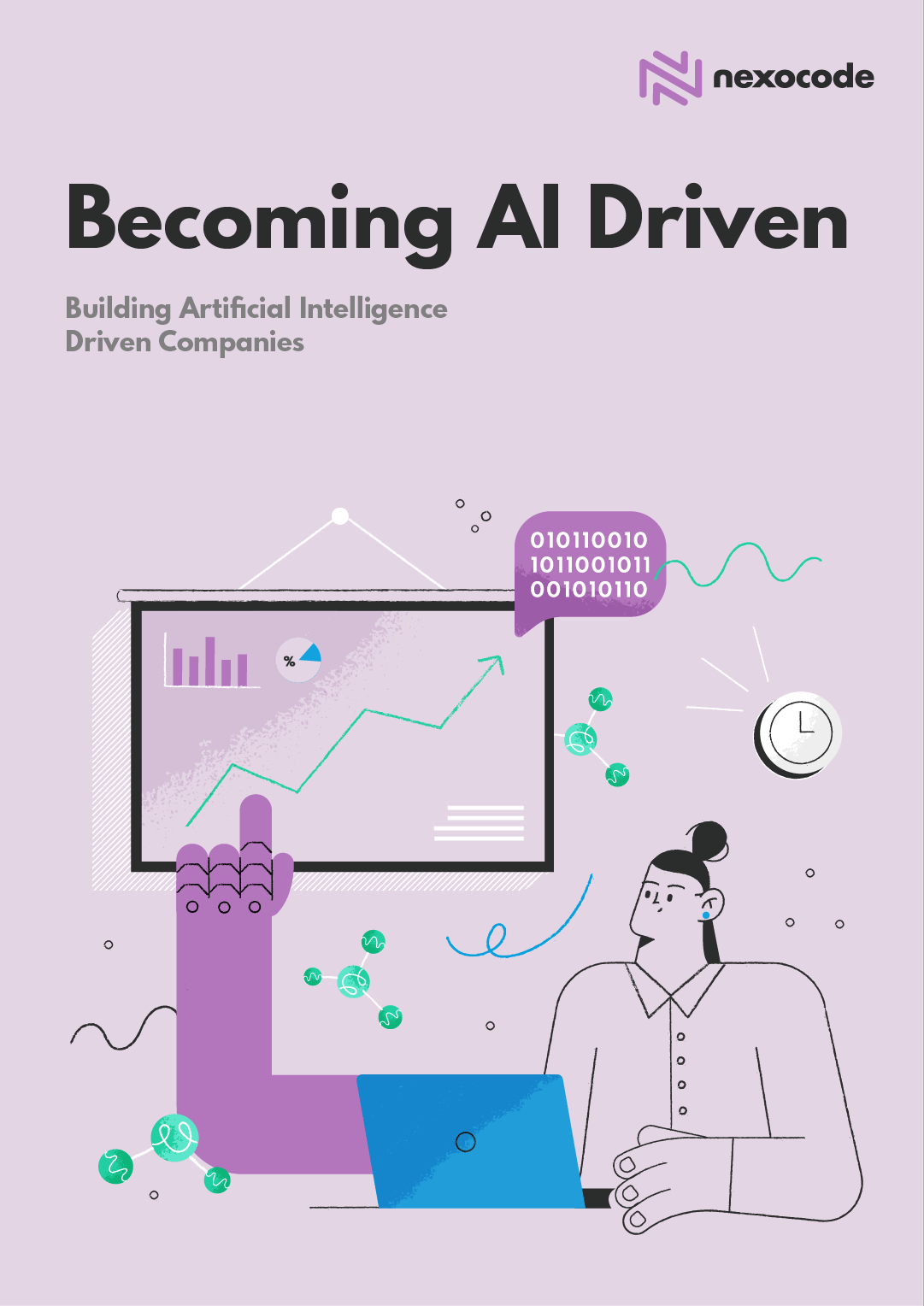In today’s fast-paced business world, data is no longer just a collection of numbers and statistics. It has become a valuable asset that can shape a company’s strategy, inform decision-making, and drive success.
But with so much data at our fingertips, how do we turn it into actionable insights? That’s where a cultural shift towards data-driven decision-making comes in.
Gone are the days of gut instincts and guesswork. By following a structured process of data collection, cleaning, data science analysis, and implementation, companies can share insights and make informed decisions based on hard evidence.
But what does this process look like in action? And how can businesses create a culture that values and utilizes data to its full potential?
Let’s dive into the exciting world of data-driven decision-making and discover how businesses can align their strategy with data analysis to stay ahead of the competition.
TL;DR
• Data-driven decision-making is a process where data is used to inform business decisions. The process includes several steps: starting with data collection, data preprocessing, exploratory data analysis, extracting valuable insights and making decisions, and automation and democratization of the whole process.
• Companies can align their business strategy with data analysis by recognizing the value of data as a key company asset. In order to allow for data culture to thrive, the company needs to streamline data accessibility, thoroughly plan a data strategy, create an adequate data infrastructure, and employ the right tools and people.
• Nexocode data engineers can help you create advanced data analytics systems and build effective data strategies. Whether you’re just starting out with data or looking to take your data-driven decision-making to the next level,
our team can provide the support and expertise you need.
Definition of Data-Driven Decision Making
Data-driven decision-making (DDDM) is the process of making data-informed choices about how to best achieve a business objective. In essence, DDDM is about collecting and analyzing data to draw the right conclusions and move your business forward.
This could include things like data mining and predictive analytics, but it also involves more mundane tasks such as data cleaning and data visualization. In short, data-driven decision-making is about using the information you have available to determine the best course of action for the benefit of your organization before making any commitments.
Depending on the kind of data you have at your disposal and your business objectives, there are a variety of methods to include data in one’s decision-making process. Consider what types of quality information is available to you and how it can be utilized for maximum effect.
Importance of Data-Driven Decision-Making in Business
Data-driven decision-making has become essential for businesses looking to stay competitive in today’s data-rich environment. Having data at their fingertips enables businesses to make better-informed choices far more efficiently than before.
While gathering and evaluating data has been fundamental in business for some time, it’s simpler than ever before for organizations to gain tangible insights from the vast amount now produced every day. That makes the current trend towards increased data-driven decision-making a powerful tool for businesses of all sizes and industries.
Big data, data science, and machine learning have become essential in understanding customer behavior, predicting trends and optimizing operations. With DDDM, such information is collected and analyzed in real-time, enabling businesses to react quickly to changing conditions and remain sufficiently agile to make reliable and profitable decisions.
Using data-driven decisions instead of gut instinct or guesswork can improve the accuracy of decision-making and lead to better results. As data-driven decisions are based on hard evidence, companies can be more confident that their choices will truly drive profitable results in the long run as opposed to focusing on short-term gains.
The Data-Driven Decision-Making Process
Data-driven decision-making is not a one-size-fits-all approach; every organization needs to tailor the DDDM process to their own data and objectives. However, the data-driven decision process can generally be divided into the six distinct steps outlined below (plus the initial step of actually determining what those business objectives are).
Step 0: Set Business Objectives and Identify Business Opportunities
Before properly starting the data-driven decision process, it is necessary to understand your business goals and identify areas of untapped potential in the market in order to increase your likelihood of success.
Companies first need to determine what data is most critical to them for achieving those business goals and identify data-driven opportunities that may facilitate organizational growth, otherwise, the process will simply boil down to data analysis without any real purpose.
Step 1: Data Collection Process
Data can be collected from both internal and external sources, including data warehouses and data lakes, as well as third-party providers. Identifying the right data sources is a critical component of data-driven decision-making.
The data collection process involves not only the actual data gathering process, but also data validation. This is where data quality assurance takes place to confirm data accuracy and completeness by identifying and correcting errors.
Step 2: Data Cleaning and Preparation
Getting the gathered data into a suitable condition for analysis is the next step. Pre-processing entails taking raw data and transforming it into a consistent format for easy storage, manipulation, and analysis.
This stage consists of data cleaning – verifying data consistency and accuracy by removing outliers, replacing missing values, and standardization into a uniform data type to eliminate inconsistencies and simplify data manipulation – plus preparation – combining data, organizing, data, and formatting data so that analytics software can effectively interpret it.
Step 3: Data Analysis (Data Science, Machine Learning, Artificial Intelligence)
At the heart of the process is exploring data to uncover patterns, trends, and relationships that can be used to inform decisions. This can include data mining and data visualization, among others – the former is about identifying hidden patterns, relationships, and trends in data, while the latter provides insights into data by creating graphical representations.
Modeling by utilizing data science techniques such as machine learning and artificial intelligence can also make up part of the analysis process. Data science involves using advanced statistical and mathematical algorithms to identify patterns in data, enabling the data to “speak” for itself.
Step 4: Drawing Insights and Making Decisions
The data analysis process should ultimately lead to the development of actionable strategies that can be put into practice. This entails interpreting data, storytelling to communicate insights in a more engaging way, and identifying any potential opportunities or risks.
Decisions can then be made and solutions implemented on a data-driven basis. It is crucial to remember, though, that all strategic business decisions should also take into account various data sets and qualitative research that may not be easily captured in numbers.
Step 5: Implementation and Monitoring
The data-driven decisions that have been made now must be put into practice. Implementation may involve developing data-driven processes and systems, building data pipelines for data flow, and creating data dashboards for data visualization.
These data-driven decisions need to be monitored closely in order to confirm that the data-driven objectives are being met. It is also vital to continually evaluate data analysis results and data-driven strategies so that they remain relevant and effective in the ever-changing data landscape.
Step 6: Automating Data Analysis Process for Future Use
Once successful data-driven decisions have been made possible, it is no longer necessary to repeat every step manually next time. Instead, the data analysis process can be handled more efficiently by automating data collection, cleansing, manipulation, and analysis.
This automation process allows data-driven insights to be generated faster and more accurately, reducing the amount of time spent on DDDM by eliminating the need for data processing and analysis from scratch.
Automation lets data analysts focus on data quality assurance and data-driven strategy formulation rather than manual data manipulation. Democratization of data-driven decisions can then be achieved by creating a data culture within the organization.
This requires increasing data literacy, fostering data collaboration and data sharing, and enabling data analysis for everyone within the business. Such a data culture can then be used to inform data-driven decisions that are aligned with business objectives.
One immediate benefit of data democratization is giving even users with limited technical know-how the confidence and capability to analyze data and draw meaningful insights from it. The reliance on experts in data analysis to generate reports, identify trends, and create visualizations that foster data-driven decisions is then massively reduced as a result.
Making a Shift To a Data-Driven Culture: Common Challenges
Democratization of the data-driven decision-making process requires more than just data collection and data analysis. It relies on cultivating a strong data-driven culture throughout the organization.
However, that is not something which is easily achieved. Many data-driven initiatives fail to take off for several typical reasons, with organizations looking to introduce a data-driven culture facing a lot of the same obstacles.
Ensuring Data Accuracy and Relevance
The data environment is constantly evolving and data sources can be unreliable. As such, data quality must be monitored throughout the data analysis process in order to verify that it remains accurate and relevant data.
To overcome this challenge, data-driven organizations need to create clear data governance policies that provide clear guidance on data collection and usage. It is also beneficial to have data stewards who can review data quality and provide expertise as needed.
Overcoming Resistance to Change
Cultural aversion to a data culture can be rooted in a lack of data literacy or a general skepticism of data-driven decisions, among others. It is, therefore, vital to remember that data is just one part of a larger decision-making process, and that data should be used as a tool to support decisions rather than a replacement for human expertise and judgment.
Organizations need to foster data literacy and encourage data-driven decision-making by demonstrating its clear benefits. Identifying data champions within the organization who can become data ambassadors and rally data initiatives to lead the transformation to a data-driven culture will also play a part in overcoming resistance to change.
Building a Data-Driven Culture
Making the shift to DDDM is an ongoing process that will take time and dedication. It requires awareness, data literacy, collaboration, and data sharing throughout the organization.
That said, with the right strategy and resources in place, data democratization can unlock new opportunities that enable businesses to stay competitive in a data-driven economy.
Organizations looking to build a data-driven culture must insist on implementing data-driven processes and providing data literacy training for all users, regardless of technical proficiency.
Investing in the Right Technology and Talent
Effective data analysis relies on the support of effective tools and data infrastructure, as well as a team of data-savvy experts to oversee the process.
Any organization striving for a data-driven culture ought to invest in data warehousing technologies, analytics tools, visualization platforms, and data science expertise to build data-driven processes and empower DDDM.
Employing professional data engineers who can assess data pipelines and data architecture requirements, as well as develop custom data models and effectively mine data for actionable insights, is key to accurate and efficient data analysis.
Automation tools allow data analysts to focus on data quality assurance and data-driven strategy formulation, without having to spend too much time data wrangling. Companies can choose a platform that automates data extraction, data transformation, and data loading processes – freeing up data analysts to focus on generating insights.
Embracing Experiments – Gather Data Samples by Running Tests
Data-driven culture often necessitates data exploration, so it is instructive to have some reference points in the data analysis. Businesses can run experiments on data samples and gather historical data points from many sources – e.g., client preferences, usage, and customer data – to explore new data sets, understand behavior, and reveal growing trends.
Tapping into data sets that were previously inaccessible or unknown can add a layer of understanding to data analysis, as well as uncover new opportunities. Experimentation with data samples gives businesses the chance to test hypotheses and theories, which can in turn inform data-driven decision making.
Shaping Business Strategy with Data Analysis
Organizations can unlock the power of data in order to optimize their approaches and gain a competitive edge. Recognizing data as an essential resource enables companies to leverage data-driven insights in order to drive business growth and create sustainable data-driven strategies that align with their objectives.
Identifying Data as a Key Company Asset
Businesses must recognize data as a crucial resource and invest accordingly in data-driven processes to guarantee its secure collection and storage. Doing so lets data engineering teams efficiently transform data into actionable insights, which can in turn be used to optimize processes and drive business decisions.
Without data governance policies in place, those data-driven processes won’t be able to reach their full potential. Companies must therefore implement data security protocols that protect data privacy and limit access to data, whilst simultaneously encouraging data sharing and democratization.
Streamlining Data Accessibility
Organizations must strive to make data readily available to all users, including business leaders who may not have technical data knowledge, in order to facilitate the generation of data-driven insights.
Companies thus ought to invest in self-service data analysis tools for non-expert stakeholders that allow data to be explored, shared, and applied in the decision-making process.
Also, data-driven culture must extend to all data users, regardless of data literacy – data teams should communicate data-driven concepts and insights in a language that can be understood by all data stakeholders. One method for doing this is to create data dashboards that provide data-driven insights in real-time and tailored views for data visualization.
Organize Data with a Thoroughly Planned Data Strategy
The data-driven decision-making process requires data to be accurately organized and managed in order for data teams to effectively extract actionable insights from it. Companies should therefore develop data-driven strategies for data collection, quality assurance, transformation, and storage.
Organizations undergoing a digital transformation must also establish data governance policies and teams in place to monitor data security and verify that data collection protocols meet data privacy laws and regulations. Moreover, any well-planned data strategy must be regularly assessed and adjusted to keep it up-to-date with the company’s objectives.
Data-driven decision-making is reliant upon data science practices and professionals with the knowledge and technical skills to uncover hidden opportunities in data sets. As a result, companies can benefit from seeking out data professionals with a strong data background and the ability to communicate data-driven insights in a clearly understandable manner.
Moreover, DDDM should be underpinned by technological solutions, such as data visualization tools (e.g., Tableau) or data analysis software (for example, R).
Every organization seeking to build a data-driven culture would also benefit from implementing data-driven processes that allow teams to explore data, make predictions, and interpret data-driven insights in an actionable way.
Optimizing Operations and Resource Allocation
Data-driven decision-making offers organizations the chance to maximize the efficiency of their processes by assigning and prioritizing available resources according to data.
This approach allows data teams to identify areas where data can be used to optimize operations, such as automating manual tasks or providing a more relevant customer experience.
Assessment of data patterns enables data scientists to identify areas in which their organization can improve and use data to make informed decisions about resource allocation, product development, customer service, marketing strategies, and more.
Building Data Literacy and Making Data-Driven Decisions
Finally, data-driven decision-making will only be successful if data teams are able to understand data terms in order to apply data-driven principles to their work. Companies can promote data literacy by providing less data-savvy employees with data training and possibilities for hands-on experience.
Additionally, data teams should maintain an environment of collaboration and knowledge sharing. Effective DDDM requires data to be visualized in a way that allows all users to draw conclusions that are meaningful, which is why creating data dashboards and data stories are useful for sharing insights in an accessible manner to trigger data-driven decisions.
You Need To Understand Your Data Potential and Build Adequate Data Infrastructure
Data-driven decision-making requires data teams to have excellent data skills, data analysis tools, data governance systems, and adequate processes in place. Companies that invest in data infrastructure and talent have the necessities to generate data-driven insights and use data to make informed business decisions.
However, an organization must first comprehend its data potential in order to build an effective data-driven approach that achieves the best possible results. Following data-driven practices enables companies to make data an integral part of their business strategy and drive better decisions for the future.
Now that you know the above-mentioned steps in the data-driven decision-making process and how to overcome some common challenges, you can get started on your data journey.
Start by understanding data and its potential to help your organization make informed decisions, and do not hesitate to
contact data experts at nexocode if you need any assistance along the way.









